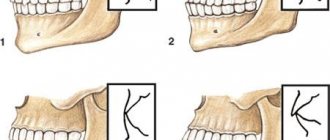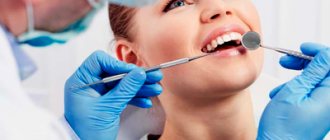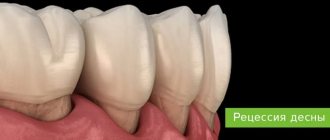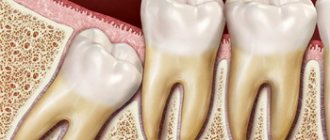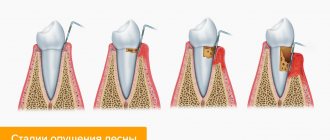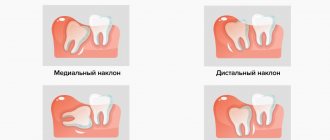Bite is the way the dentition interacts when the upper and lower jaws are completely closed. An incorrect bite almost always leads to the fact that the enamel, and behind it the bone tissue of the incisors, canines, and molars, quickly wears out and is destroyed. That is why correct human teeth bite so important.
If you have any problems with your teeth, they can be corrected. But this will take a lot of time, because the teeth cannot just be moved, they need to be moved gradually. While studying the problem, doctors came up with many ways to combat malocclusion.
Types of human bite
There are three types of bite in people : ideal, correct and incorrect. Ideal is very rare. For a doctor to say that your jaws have no defects at all, they must meet certain characteristics. Let's list them:
- the upper dental arch has a semi-elliptical shape;
- the lower dental arch looks like a parabola;
- the arches are opposite each other (the front one is slightly in front), when closing, each upper tooth is in contact with the lower one;
- there are no obvious gaps between the teeth;
- The upper teeth overlap the lower teeth by a third.
an ideal jaw in patients, because there is still some minor flaw. Most often these are gaps between teeth or a not very smooth upper arch. But, if this does not interfere with life and chewing, the doctor will not treat or change anything. Sometimes a malocclusion is formed due to bad habits. Trainer systems will help avoid this.
Correct teeth bite
Correct bite is the closure of teeth without defects or with small defects that do not negatively affect the general condition of the oral cavity. This means that with any of the options, a person has no problems with chewing, speech, cosmetic problems are not visible, etc. Four photos of a person’s correct bites are presented below.
Fig 1. Four types of correct bite
Orthognathic
Orthognathic is the most aesthetic occlusion. With it, all the teeth are even, there are no cracks or spaces between them, the upper row of teeth overlaps the lower row by about 30% of the height. This is one of the most popular incisor placement options.
Straight
The direct type of bite in people is quite common and is easy to determine: in this case, the teeth touch the cutting edges and do not cover each other. In this case, the smile looks a little specific and turns out wide, but retains its aesthetics and healthy appearance.
Biprognathic
A biprognathic bite is characterized by an even row of teeth with no gaps, but the teeth do not grow straight down. They are slightly pushed forward, although only slightly.
Progenic
A progenic bite with normal tooth development also does not have any anomalies such as spaces between the incisors or molars. The correct jaw of this type has only one feature: in it the front lower teeth move forward slightly.
What is correct (physiological) bite
Physiological types of occlusion are characterized by the correct closure (occlusion) of the teeth. There should be no gaps, gaps or bony protrusions between the teeth. Correct occlusion is established only when all teeth are located along the center line.
Correct types of occlusion do not involve disturbances in chewing function. The upper jaw is shaped like a semi-oval, and the lower jaw resembles a parabola.
A physiological bite gives a person the following advantages:
- aesthetic smile;
- correct articulation and clear speech;
- correct primary processing of food (chewing).
Malocclusion of teeth
Malocclusion is a big problem that requires treatment. The most effective way to correct the position of the dentition is in children. At 30-40 years old it is possible to cope with the problem, but in adults it will take much longer. Below in the picture you can see five popular malocclusion pathologies, which often affect not only the jaws, but even the way the face looks.
Fig 2. Five types of malocclusion
Distal (prognathic)
from the normal bite by its highly developed upper jaw. As a result, it bulges forward, which also changes facial features. Severe manifestations of this type of dental development disorder may require surgical intervention.
Mesial (medial)
With mesial pathology, the lower jaw is more developed, which can move forward strongly or not very much. from the progenic correct arrangement of teeth in that the lower teeth are not only slightly protruded, they almost completely cover the upper row. This type of bite is dangerous because the outer enamel of the upper incisors and canines quickly wears down, leading to caries.
Cross
A crossbite is characterized by the following characteristics: there is free space between the teeth, with some of the upper jaw incisors located in front of the lower teeth, and some behind them. This arrangement is also described as a “scissor-like intersection.” It looks very unaesthetic, and almost always with a crossbite the teeth grow in different directions.
Deep
A deep bite differs from a regular jaw in that the upper row of teeth almost completely overlaps the lower one. It is also considered an anomaly if the incisors cover the dentition by more than 30%, although sometimes the abnormalities are not visible. For example, the average person is unlikely to distinguish between a tooth overlap of 30% and 40%, since the difference between them is small.
Open
With an open bite, the upper and lower dentition are in contact with only part of the chewing teeth, and pronounced gaps appear between the incisors of the jaws (most often). Sometimes it even feels like the mouth is not closed.
Any dental pathology must be treated, because a correct bite is the key to the health of the entire oral cavity and even your gastrointestinal tract. After all, the better the food is processed by the teeth upon receipt, the easier it is to digest.
Other signs
There are indirect signs of malocclusion.
- Reduced height of tooth crowns.
Typically, the front teeth are rectangular in shape. If they become square, this may be due to thinning enamel. The thickness of the enamel on the cutting edges and chewing cusps of the tooth is about 2 mm. Due to an incorrect bite, the enamel wears off and the teeth become more square in shape. This is a clear sign of an “age-related” smile, but for young people it is not the norm (unless the teeth were square from the very beginning).
Worn teeth
- Increased tooth sensitivity.
The reason is the same - the enamel becomes fragile and thin. Teeth begin to ache from hot and cold, sometimes from sour and sweet.
- Pain or clicking in the jaw joints.
They are often unnoticeable because many people eat mostly soft foods and do not spend much effort chewing. Problems with the jaw joints usually appear when trying to chew solid food. Most often, the cause of dysfunction is malocclusion. The jaws are positioned incorrectly relative to each other, so the joint is loaded unevenly.
- Discomfort when chewing or biting.
The more complex the disorder, the more noticeable it is that when chewing the load is distributed incorrectly. With an open bite, for example, some of the teeth do not close together at all, so it is difficult to chew food well.
- The symmetry of the smile is broken.
The easiest way to determine this is to look at the centers of the upper and lower jaw. They must match.
- Some teeth have a wavy edge.
The permanent teeth grow with wavy edges. And only then do they gradually grind down and become straight. This happens due to chewing. If one of the teeth is slanted or turned so that its edge is higher than all the others, it will remain wavy because it will not grind down.
Wavy edge of teeth
- The symmetry of the face is broken.
This sign needs to be assessed by looking not at the teeth, but at the face as a whole. Normally, the nasolabial folds are symmetrical. If only one of them appears, this indicates that the jaws are located asymmetrically.
- Obtuse angle between neck and chin.
If the lower jaw is too small or pushed back, a double chin may appear at a young age. This is due to the fact that due to the position of the lower jaw, the angle between the neck and chin is flattened.
Perhaps your chin looks small due to problems with your bite
If you have any doubts about the health of your teeth, consult a doctor - only an orthodontist can make a final diagnosis at an appointment, after which, if necessary, treatment can be planned.
Bite in the absence of teeth
It’s interesting, but even if you have no teeth at all, there is no guarantee that with prosthetics you will be able to create the right jaw . It all depends on how damaged the dental system was before removing all its elements. If the jaws are within normal limits relative to each other, the doctor will be able to make adjustments to the prosthesis. If there are also problems with the bones, more complex methods of restoring the dentition will be necessary.
In the absence of teeth, the bite in people is determined using special wax rollers that are placed in the mouth and allow measurements to be taken. The instruments used are a ruler arc and an intraoral plate. Next, a plaster and then a regular prosthesis is created.
Orthodontic treatment is a real health concern
In our opinion, orthodontic treatment is the most typical example of dental care with minimal intervention in the human body, care that allows you to avoid not only dental problems, but also health problems in general.
We call this approach “Real Health Care.” The key to this approach is to plan treatment and prevention in advance to avoid serious problems in the future.
If you have never visited an orthodontist, perhaps now you have the intention of scheduling a visit to the White Nights clinic.
Be healthy, and we are always here.
Bite after wisdom tooth removal
In modern man, wisdom teeth are an atavism, that is, an element that seems to be there, but is not required in life. They do not affect the correct closure of the teeth and do not harm the dentition in any way if they erupted correctly. This is why dentists recommend not touching wisdom teeth and not removing them unless necessary.
But if you decide to form the correct bite of your teeth as an adult, useless “eights” can serve you well. The fact is that after their removal, the dense dentition becomes freer, so that the remaining teeth can be positioned correctly.
How to independently determine whether it is good or not. Who can check
Usually, an incorrect bite is immediately visible because it can negatively affect a person’s face. If you have at least one friend or acquaintance with incorrectly positioned teeth, you know that such people often have difficulty speaking or biting food, and they develop a variety of speech defects. But, alas, only obvious violations are obvious to the average person.
It is important to understand that a correct bite is a complex of characteristics of your dentition. Even if you have a nice smile and your front teeth are nice and neat, there is no guarantee that everything is actually perfect. Meanwhile, this is fraught: miss one problem, and it will lead to large expenses for the treatment of damaged teeth.
You can imagine what a correct bite should be like in an adult or child, but only an experienced doctor can make a diagnosis.
The importance of proper bite for a person
Correct bite, timely dental treatment and careful hygiene are of great importance in a person’s life. Already in the 19th century, they understood the importance of the correct arrangement of the dentition and began to study its features. The main advantages of a correct bite:
- a beautiful and aesthetic smile that attracts people and helps them move forward in life easier;
- correct articulation, clear and understandable speech;
- ease of chewing, biting vegetables, fruits and much more.
Both in childhood and in adulthood, it will take time to form the correct bite. But it’s worth spending, because your health largely depends on the correct position of your teeth. And in business or in life, a beautiful smile often helps to establish strong personal or business relationships. Therefore, healthy teeth are very important.
Problems caused by malocclusion
Malocclusion in people almost always leads to quite serious problems, and not only with the oral cavity. Among the consequences of incorrect closure of the dentition are:
- Increased stress on teeth, which leads to premature tooth loss. It is possible to develop periodontal disease, which accelerates the process. As a result, by the age of 40-50 a person is left without teeth.
- Unpleasant gum sensitivity. The gums begin to react to hot and cold foods, and often unsightly and painful ulcers form on them.
- Disease of the temporomandibular joints. It is also caused by excessive stress, since it is this organ that compensates for the absence of some teeth. It all starts with discomfort, pain, clicking sounds and tingling in the masticatory muscles. Next, your head will begin to hurt systematically, and changes in appearance may also appear.
- Problems with the gastrointestinal tract. There are many types of gastrointestinal diseases that appear due to poorly chewed food. The lack of necessary processing of food entering the stomach leads to excessive stress on the organ, and its strength limit is not infinite.
- Psychological consequences. A person sees a flaw in himself and this creates uncertainty, an inferiority complex, low self-esteem, modesty, timidity and other psychological problems.
Remember that the formation of a correct bite is a matter of health, and not just a solution to aesthetic problems. This is why it is so important to see a dentist on time.
Important! If a child has a malocclusion on his baby teeth, it must also be treated! Although the teeth will be replaced over time, they will grow in the same places where their milk predecessors were. In addition, in childhood the body adapts faster and recovers more easily, so treatment will be faster.
Stages of bite development
By the age of 12, a child usually begins the process of active formation of a permanent bite, which includes the following stages:
- at the age of 13-15 years, a period of development begins, active growth of the alveolar processes, eruption of second molars, this stage ends only by the age of 18;
- The period of preformation lasts from 18 years to 24-25 years, at this time the dental arches develop, and the jaws acquire their final size. At the same time, third molars erupt, although experts note that not everyone has wisdom teeth;
- The final formation of the bite ends when a person has all 32 teeth, at which time development stops, but mesial displacement can continue throughout life.
In the process of forming a permanent bite, not only the position of the teeth changes, but the proportions of the face.
How to effectively correct an overbite. Treatment methods for abnormalities
Treatment of dental malocclusion begins with assessing the condition of the oral cavity and carefully studying the problem. Next, the dentist can recommend one of the popular ways to restore the correctness of the dentition:
- Braces. They can solve almost any bite problem. They are divided into metal, plastic and ceramic, sapphire, self-ligating, lingual. Each type has its own advantages, for example, metal ones are the cheapest, but also the most noticeable, but lingual ones are very expensive, but are placed on the inside of the teeth, so they are not visible.
- Kapu. A mouthguard is a removable polymer structure that is harmless to enamel and can be easily removed while eating or brushing your teeth.
- Surgical intervention. Allows you to correct almost any bite problem. It is required only in very complex cases, usually with congenital pathologies.
- Laser treatment. This is not an independent way to correct a bite. Auxiliary procedures using lasers accelerate regeneration and help reduce the risk of complications.
Modern methods are almost always safe and cause only minor discomfort. But after the course of treatment you will not recognize yourself: you will become more confident, braver, healthier. And sometimes the correct bite changes the appearance in the photo and in reality, forming healthier and more pleasant facial features.
Fig. 3. Braces and mouth guard for malocclusion treatment
Option #1. “Conventional” braces, in which the clasps and archwire are attached to the outside of the teeth
This is the most economical and at the same time very effective treatment option.
The main disadvantage of such brace systems is that they are noticeable to others. But if you want the brace system to be less conspicuous, you can choose plastic, ceramic or sapphire locks.
Also, braces systems differ in the design of the locks in which the metal arch is attached. In a simpler version, rubber bands are used to attach the arch, but they make it difficult for the arch to slide inside the braces and create additional stress on the teeth.
In self-ligating bracket systems, the arch is held without additional fastening and at the same time slides freely inside the bracket. In addition to greater comfort, this design reduces treatment time and reduces the number of visits to the orthodontist.
Conclusions. Expert advice
There are many different types of overbite. Correct is an arrangement of teeth that does not interfere with chewing or speech. If the teeth are not closed properly, excessive stress is placed on the teeth and they are destroyed faster. The bite is preserved even in the absence of teeth. Removing a wisdom tooth does not disrupt the bite and is not mandatory, but may be recommended in case of correction of damaged dentition.
Even if you know what a correct bite looks like , you will not be able to make a correct diagnosis. But you can appreciate the importance of correct bite and the global nature of the problems that its violation causes. This is a good motivation to visit the dentist. The doctor will make a diagnosis and offer modern methods of correcting the bite: installing braces, wearing a mouth guard or other methods. On average, treatment takes from one to 3 years, depending on the complexity of your case.
FAQ
Is it possible to correct an overbite without braces?
Yes, you can, but under certain conditions determined by the doctor. Malocclusions can be treated using orthodontic plates, trainers or aligners.
Is it possible to correct an overbite at home?
It is impossible to correct a crooked bite at home. There are exercises to strengthen the muscular system, but they are ineffective and are used only in addition to the main therapy.
How long do you need to wear braces for an overbite?
Depends on the degree of damage and the age of the patient. The minimum wearing period is 6 months. In some cases, braces are worn for up to 3 years.
Is it possible to get veneers if you have an incorrect bite?
It is possible, but only with minor deviations from the norm. Otherwise, orthodontic treatment is initially carried out, and only after that is it permissible to install veneers.
How much does it cost to correct a bite?
It all depends on the amount of work. First of all, you need to undergo a diagnosis. Mild degrees of malocclusion respond well to treatment with removable orthodontic structures. In such cases the price will be low.
